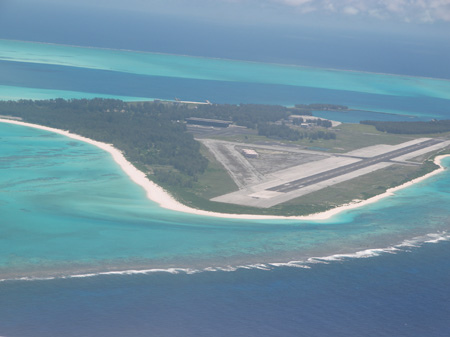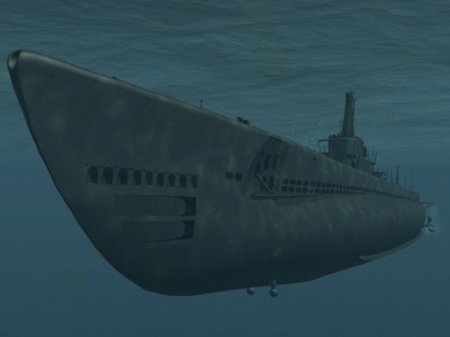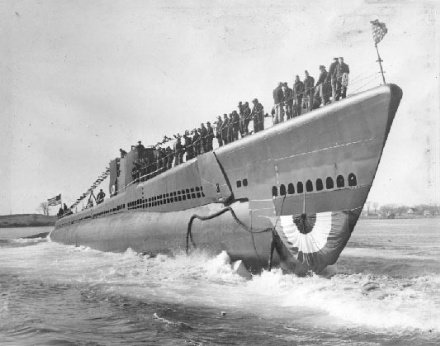
THE SAILING LIST FOR THE FIRST WAR PATROL OF THE USS ATULE (OCTOBER 1944)

MS ASAMA MARU WAS A JAPANESE OCEAN LINER BUILT IN 1929 FOR THE NYK (NIPPON YUSEN KAISHA) LINE. THE SHIP WAS CONVERTED TO A TRANSPORT FOR WORLD WAR II. IT WAS THE FIRST SHIP SUNK BY THE ATULE.

SITE OF THE SINKING OF THE MS ASAMA MARU IN THE SOUTH CHINA SEA. THE SHIP WAS SUNK ABOUT 270 MILES SOUTHEAST OF HONG KONG AND ABOUT 100 MILES SOUTH OF THE ISLAND OF PRATAS
By JOHN R. BAKER
CHAPTER SIX: OUR FIRST WAR PATROL
It is now late summer of 1944. We have at last traversed the Panama Canal and finally realize that the war in the Pacific against the Imperial Japanese Navy is the next item on our agenda. All the way to the Hawaiian Islands area we trained steadily, in company with the USS Jallao (SS-368). Drills pertaining to flooding, fires and other emergencies. We practiced over and over the things we planned to do for real once we were in enemy waters. These tests were ordered night and day by our skipper. Special emphasis was made on our diving procedure due to the inexperience of most of our officers. We practiced night surface, radar depth, submerged attacks constantly. Lookouts got a lot of practice in sighting periscopes as we took turns practicing with Jallao. The tracking party, i.e. those who would actually send our torpedoes into the enemy, got to be very good, and it paid off, because later on our torpedoes were dependable and accurate!
By mid-September of 1944, O’Toole reached Sub-base Pearl and reported to Com Sub Pac Vice Admiral Charles Lockwood, known as Uncle Charlie, but not by enlisted men. More training close to the islands and last minute improvements to the boat itself made us at last ready in all respects for action. On October 9, 1944, we left Pearl and headed for our first war patrol. We were headed for the South China sea area in company with USS Jallao and USS Pintado (SS-387). We were a wolfpack of three. (One of our crew put the first initials of the boat’s names together and got J. A. P.) Add the word “PATROL” and that’s what we were. The wolfpack tactic was a skillfully contrived German concept whereby a group of submarines, operating mainly on the surface, reinforced one another both by scouting the enemy and coordinating attacks. This maneuver covered many more square miles of ocean, and even though our boats weren’t in sight of one another, we kept in close touch using the newer VHF radio.
Early during the war, U.S. Submarines successfully employed this plan for the test of the war. The American invasion of the Philippines began while we were headed West, and we soon found ourselves involved. Many Japanese warships and transporters were in the area as the enemy desperately tried to repel the American landings. Atule was able to spot a Japanese light cruiser and notified the rest of our pack. Jallao drew first blood! She sank the light cruiser. A few days later our turn arrived. On Halloween night, 1944, while we were on the surface, we sank a large troop transport that was headed to Leyte Gulf. She was the Asama Maru, a former ocean passenger liner. Several escorts accompanied the victim, so we promptly submerged. Soon they started depth charging, to the detriment of the swimming survivors, I’m sure, but they never came very close to us. Incidentally, in later attacks we always fired our torpedoes while we were surfaced, and we never dived as part of the attack. We thought of ourselves as a Navy ship which could fight on the surface and had the ability to submerge if necessary. The enemy ship probably carried 3,000 to 5,000 troops, and the sound of that huge ship breaking us as she sank into the depths will never be forgotten.
Perhaps I should mention that our last contact with America was always the island of Saipan where we would rendezvous with the anchored submarine tender USS Fulton (AS-11). Here we conducted refueling, either preparatory to heading out to the fighting zone or on our way back on our way to rest camp. We would get three weeks between patrols. Our first visit to Tanapag Harbor and to Saipan October 21, 1944 was an eye-opener to the effects of battle for most of us. The initial Marine landings had been made in June of 1944 on the 71 square mile island following the strategy of occupying “stepping stones” towards the home islands of Japan. While Atule was refueling and loading last-minute stores the crew all got to go ashore for a beer party. All of us loaded into small boats and accompanied by armed Marines we headed to solid ground. That sandy beach was unbelievable. Not a tree left in sight, just shattered stumps, none over about three feet high. Trash of all kinds, especially a myriad of sake bottles — thousands of sake bottles — as well as all of the smashed and wrecked military junk you could imagine. I even saw a chromed bread toaster amongst all that stuff! We were given strict orders not to collect any souvenirs because of the possibility of booby traps.
And now, a word about our beer. I may be giving away a military secret, but during the D-Day landings in June 1944, some of the small landing crafts were loaded with G.I. issue canned beer. Some of them hadn’t made the beach and scuba divers had to go down to collect the olive-drab cans in gunny sacks. Yep, our ration of two cans was starting to rust and were all coated with sand. I’ll never forget the brand — Fishbach — because I was immediately hit with the worst headache I’ve ever had before or since. The blinding sun and G.I. beer, after two weeks inside a dark submarine, was more than my delicate nature could stand.
Saipan still was not secure, quite a few of the enemy were still above us on the hillside, in caves. It was here that I saw my first-ever helicopter patrolling along the beach, and also Navy fighter planes firing rockets into the caves. Later on, we saw that those same uplands had been made into an American cemetery. When you look at 4,000 white crosses you will always be able to realize the meaning of casualties. Two of my Marine cousins from Minnesota, whom I had never met, are in that place.
But now we are well into our patrol and having success. Statistically, our first patrol lasted 63 days, and Atule recorded 11 hits from the 22 torpedoes fired during four separate attacks resulting in the sinking of five major enemy ships.
At this time I should mention that not all of the torpedoes fired during an attack are expected to connect. No, the idea is to fire a spread, usually four to six torpedoes, depending on the target’s size, so there is an overlap. The first and the last shot may miss at the bow or the stern, but at least one torpedo should strike M.O.T. (Middle of Target) for the most productive damage. Eleven out of 22 is considered pretty good. Of the six fired at Asama Maru, two and possibly three struck the enemy. At least she went down in about four minutes. With a well trained tracking party, one of the overlaps just might collect an escort even if it missed the main target. Our tracking was pretty good, and later on we did just that!
Our second successful attack occurred on November 20, 1944. At about 3:30 a.m. our SJ radar picked up a good pip at about six miles. After determining that it was an enemy ship, we commenced tracking. Enemy was identified as a destroyer. At around 5 a.m. we fired four fish from our stern tubes. The first struck with a terrific explosion at about his forward stack. Two and one-half minutes later his stern reared straight up and he slid under. His depth charges kept going off as he plunged deeper and deeper into the depths. No survivors.
The very next evening one of the lookouts spotted the lights of a properly marked hospital ship. Had him in sight for quite awhile. He was probably headed for Singapore and was making about 12 knots. Of course, he never knew we were in the vicinity and had a close eye on him.
Up until now, on this patrol, we had had over 20 aircraft contacts. Some very close. We avoided many of them and didn’t always dive, but those planes from the Philippines had radar so consequently we frequently did have to submerge as they keyed on us. We even had some of their planes covering our VHF wolfpack frequencies and asking us in good English to “Come in please.”
On the afternoon of November 24, 1944, Atule detected echo ranging on a bearing of 200 degrees True. By 1400 we had four ships in sight and we went to battle stations torpedo. This would be our third attack on this patrol. Tracking showed this group of four ships to consist of a large transport with a destroyer covering the starboard bow, a patrol craft on the port bow and another destroyer trailing astern. A group of small islands was nearby, and if they could zig-zag through them until daylight, we would be snookered. It was now or never! We eased in or the starboard flank jockeying for a good set-up at the transport and the destroyer. Flat, calm water for a change, and still they didn’t spot us! After more careful tracking, Captain Maurer announced : “The near D.D. (destroyer) and the transport overlap. Commence shooting.” As the bow torpedoes headed towards the target, Atule swung about so our stern tubes would bear. By timing with a stopwatch, the order of hits could be calculated. Torpedoes three and four hit the destroyer, which literally exploded into a funeral pyre. Nothing was left but fuel oil burning on the water. A few more seconds and # two hit the big transport followed by # seven. The transport stopped dead in the water mortally wounded and then went under in less than 10 minutes. This was a classic shot, i.e., two successive targets destroyed in one barrage. The remaining Japanese escorts made a rapid search, fired a sporadic burst of gunfire, then dropped several depth charges, but in the wrong area. As it turned out, we weren’t able to get a shot at them, so as soon as we lost radar contact we secured from battle stations. I felt elated, for on our very first patrol we seemed to be having great success.
Our final attack on this patrol was a bit different from what I imagined was a practical tactic. On November 27, 1944, after midnight, we made a good radar contact and went to battle stations. We were close to two small islands. When we approached, we identified a ship anchored at the northern end of the channel between the islands. Four shots remained in the bow tubes on this patrol and we would not be denied. Morning light would soon be coming and w didn’t want to wait much longer. Captain Maurer ordered everything made ready with four torpedoes set at 0 degree angle, i.e., all to track straight ahead. Our helmsman, Russell Miller, Gunners Mate Third Class, would direct the fish by swinging our bow across the target from left to right as the torpedoes left their tubes. Thus, each torpedo was sent on a different bearing along the enemy hull. Conditions were perfect and all torpedoes hit, one after another, and a gigantic fire erupted. She was aflame from bow to stern and heeled over as the stern settled to the bottom. We turned 180 degrees and headed away at full speed. Oh, did I mention that there were a couple of escorts in the vicinity? Our reversing maneuver got us out of there in a hurry, and, as we had fired all our fish, we couldn’t go after them. Using our five inch deck gun was a possibility, but not a good one as the odds were against us. The target burned for over an hour and lit up the sky with explosions on six different occasions. Finally, when we were about 18 miles away came the last and most brilliant explosion which blew the charred remains to bits. I was one of the crew allowed to come to the bridge one at a time to take a look at our accomplishment.
About a half hour later the # two main engine went out of service with a sheared lock plate on the vertical drive. We had no spares for repair, but Atule had three more main engines plus a “dinky” for additional battery charging power. We were okay for now. On December 2, 1944, we moored alongside the USS Fulton at Saipan and commenced refueling. Next day our executive officer, LCDR R. Bowers, was detached to become a PCO (Prospective Commanding Officer) and was replaced by LCDR Paul Schratz. We headed out of Saipan that same morning on our way to our first rest camp — Majuro Atoll. Looking at the charts we found Majuro was a circle of islands surrounding a deep harbor. A whole Naval Fleet had been assembled there earlier before the attack on Saipan, but the ships were all gone now. We had our very own island. The natives had all been moved to their own island and we never saw them. We went back and forth to the sub tender in whale boats; there were no permanent dock installations on the island.
___________________________________________________________
DECORATIONS AWARDED FOR THE FIRST PATROL
The Atule departed station with four ships sunk and one completely destroyed with a grand total of 26,700 tons of enemy shipping destroyed.
The following awards were presented for this First War Patrol:
NAVY CROSS — Commander John H. MAURER, USN, NW Washington, DC
SILVER STAR — Lieut. Comdr. Richard H. BOWERS, USN, Annapolis, MD; Lieut. Hollis F. CHURCH, Jr., USNR, South Windsor, CT; Burdell R. CARTER, TM1c, SS, USN, Chicago, IL
BRONZE STAR — Lieut. Jack _. Hudson, USNR, Marfa, TX; Lt. (jg) Charles W. PETTIT, USNR, Bloomfield, IA; Norman L. FREEMAN, CRM, USN; John S. STRINGER, CMo__, USN, Sand, TX
LETTERS OF COMMENDATION WITH RIBBON — Lt (jg) Glenn O. OLSON, USNR, Armarillo, TX; Lt (jg) Frederick A. OYHUS, USNR, Akron, OH; Davis M. McLANE, CEM, USN, San Diego, CA; Grant T. Humphrey, T_1c, USN, Long Island City, NY; Thomas E. COREY, MoMM1c, USN, lEWISTON, ME; Harold G. HALM, QM2c(T), USNR, Salem, OR; Estel E. LUDLOW, TME3c, USNR, Alexandria, IN
SUBMARINE COMBAT INSIGNIA — To all officers and men.
___________________________________________________________
1. The USS Atule — THE SUBMARINE COMBAT INSIGNIA has been awarded the Navy Unit Commendation for service during the following period(s): 9 October to 11 December 1944.
2. In accordance with reference (a) the following men, by virtue of their service in this unit during one or more of the above periods, are hereby authorized to wear the Navy Unit Commendation Ribbon transmitted herewith:
CREW OF U.S.S. ATULE (SS-403)
3. This authorization has been made a part of the official record of the personnel concerned.
By direction of Chief of Naval Personnel
__________________________________________________________
SUBMARINE FORCE, PACIFIC FLEET
6 January 1945
FF12-10/A16-3(15) — Serial: 060 — Care of Fleet Post Office — San Francisco, CA — CONFIDENTIAL — THIS REPORT WILL BE DESTROYED PRIOR TO ENTERING PATROL AREA — THIRD ENDORSEMENT to Atule Report of First War Patrol — COMSUBPAC PATROL REPORT NO. 620 — U.S.S. ATULE — FIRST WAR PATROL
From: The Commander Submarine Force, Pacific Fleet; To: The Commander in Chief, United States Fleet; Via: The Commander in Chief, U.S. Pacific Fleet
Subject: USS Atule (SS-403) — Report of First War Patrol (9 October to 11 December 1944)
1. The first war patrol of the ATULE, under the command of Commander John H. Maurer, U.S. Navy, was conducted in the Luzon Straits — South China Sea Area. The ATULE along with USS JALLAO (SS-368) and the USS PINTADO (SS-387), formed a coordinated attack group with the Commanding Officer of the PINTADO as the group commander.
2. During this outstanding patrol, the first for the ATULE, excellent area coverage was maintained, and numerous valuable targets were contacted. Enemy anti-submarine measures, particularly radar equipped night flying planes were intense. The ATULE, however, displayed a cool aggressiveness worthy of a veteran submarine in developing contacts and delivering four successful torpedo attacks which resulted in five enemy ships being sent to the bottom.
3. Award of Submarine Combat Insignia for this patrol is authorized.
4. The Commander Force, Pacific Fleet, congratulates the Commanding Officer, Officers, and crew for this outstanding first patrol. The ATULE is credited with having inflicted the following damage upon the enemy during this patrol:
SUNK
1 Large AP (EU) — 10,000 tons (Attack No. 1); 1 DD (HATSUHARU Type)(EC) — 1,400 tons (Attack No. 2); 1 Large AP (EU) — 10,000 tons (Attack No. 3); 1 DD (MUTSUKI Type)(EC) — 1,300 tons (Attack No. 3); 1 Medium AK (EU) — 4,000 tons (Attack No. 4) — TOTAL SUNK: 26,000 tons.
s/ C. A. LOCKWOOD, Jr.
Distribution and authentication on following sheet; THE ENTIRE REPORT CONTAINED HEREIN DOWNGRADED TO UNCLASSIFIED. AUTH: DOD 52009 (9-2)
___________________________________________________________
Photo Credits:
xxx




















